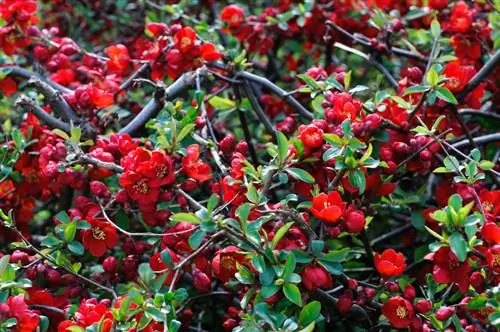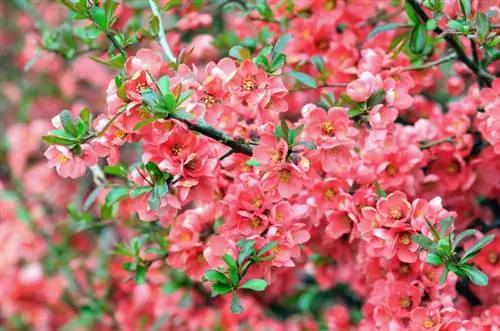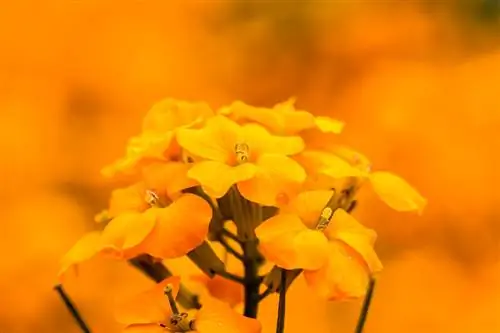- Author admin [email protected].
- Public 2023-12-25 17:45.
- Last modified 2025-01-23 11:22.
The ornamental quince is a welcome guest in every garden. With enchanting spring blossoms, lush green leaves and yellow fruit decorations in autumn, the thorny shrub has something to offer at any time. The following answers to frequently asked questions provide more information about cultivation and give tips on decorative apple fruits.

How do I properly care for an ornamental quince?
The ornamental quince is a thorny shrub that delights with its eye-catching spring flowers, green leaves and yellow fruits. It prefers a sunny to partially shaded location, humus-rich and permeable soil. Care includes regular watering, fertilizing and occasional thinning, without annual pruning.
Planting ornamental quince correctly
They strengthen the floral back of an ornamental quince when planted in autumn. After the humus-rich, permeable soil has been thoroughly weeded and raked, create a spacious pit. First shovel the excavated material into the wheelbarrow (€59.00 on Amazon) to mix it with compost and horn shavings. After the root ball has been soaked in water until no more air bubbles appear, pot it up. The planting depth in the cultivation pot is maintained as much as possible and the soil is pressed down with your hands. After a generous sip of water, finally spread a layer of mulch.
Care tips
The care program for an ornamental quince does not set the horticultural bar high. This is how you get the best out of the shrub:
- Do not allow the root ball to dry out at any time
- From March to August, fertilize every 2-3 weeks with compost and horn shavings
- Give liquid fertilizer to the pot every 14 days
- Prune only if necessary immediately after flowering
- Thoroughly thin out the wild fruit bush every 2-3 years
- Winter protection in the planting year and recommended for potted plants
Pay attention to the numerous thorns during all care and planting work. You should not forego the protection of sturdy work gloves and long-sleeved clothing.
Which location is suitable?
The prudent choice of location is one of the main pillars of successful cultivation. Fortunately, the shrub is flexible in this respect. These general conditions are important:
- Sunny, shady to partially shaded location
- Warm and protected from strong winds
- Good garden soil, containing clay, humus and fresh
- Nutritious and slightly calcareous
For an ornamental quince to achieve its optimum, the loose depth of the soil is crucial.read more
The correct planting distance
One of the outstanding attributes of an ornamental quince is that, as a small shrub, it grows just as wide as it is tall. Adjust the planting distance to this characteristic if the ornamental fruit tree functions as a solitary plant. To quickly form a dense hedge, plant one bush per meter.
What is the best time to plant?
Autumn is the time for planting all kinds of trees. In this respect, the ornamental quince is no exception. Since the soil is between 17 and 20 degrees Celsius at this time of year, the shrub establishes itself in good time before winter. In addition, the increased rainfall effectively prevents harmful drought stress, which noticeably reduces the workload for the gardener.
When is flowering time?
Depending on the species and variety, the flowering period of an ornamental quince extends from April to May or May to June. Skilled breeders have also given newer hybrids the potential for rebloom, such as the magnificent Elli Mossel. However, this requires cutting back the withered flowers, which significantly reduces the amount of autumn fruit.
Cut ornamental quince correctly
Ornamental quinces do not require annual pruning. Since the shrub flowers and produces fruit on two-year-old wood, experienced hobby gardeners allow it to grow as unhindered as possible. Nevertheless, the wild fruit tree should be thinned out thoroughly every 2-3 years. Therefore, remove all dead wood, stunted new shoots and inward-facing branches during the leafless period. In this way, sufficient sunlight always reaches all areas of the bush so that the shoots do not become bald. If you feel that the visual appearance is disturbed by shoots that are too long, the best time for a light topiary is immediately after the end of the flowering period.read more
Watering ornamental quince
Keep the root ball of an ornamental quince constantly moist, as drought stress affects the abundance of flowers and fruit in equal measure. If the soil dries on the surface, water is poured directly onto the root disc. During hot, dry summer weeks this can be the case every day, while in autumn the rain covers the water requirement.
Fertilize ornamental quinces properly
The leaner the soil, the higher the nutrient requirements. Fertilize the shrub every 2-3 weeks from March to August with compost, horn shavings, bark humus or manure. If the fruits are intended for consumption, chemical fertilizers should not be used. In the pot, apply an organic liquid fertilizer every 14 days from spring to late summer.
Wintering
The ornamental shrub is completely hardy and requires no precautions for overwintering. For reasons of caution, we recommend a layer of leaves during the year of planting to protect against cold and moisture. Cultivated in a bucket, place the ornamental quince on a block of wood in front of the south wall of the house and cover the container with bubble wrap.
Propagate ornamental quince
If you have been captivated by the magic of an ornamental quince, you can grow additional specimens using the following methods:
- Take cuttings as cracks with a little bark in order to let them root in the pot in lean soil
- Pull the sinker to the ground, bury the middle in a furrow, fix it and let it root
- Pick off root runners and let them root either directly in the bed or in the pot
Sowing the seeds is mentioned here for the sake of completeness. Since these are cold germinators, this form of propagation proves to be labor-intensive, risky and requires years of patience until the first flowering.read more
Is ornamental quince poisonous?
As part of the rose family, the flesh of ornamental quinces is not poisonous, but is hard and acidic. However, the kernels it contains should be treated with caution, as botanists consider them to contain a slight poisonous content. As part of the preparation, the fruits are boiled until soft and juiced to remove the questionable seeds. All other parts of the plant are free of the slightest amount of poison. However, the thorny branches should be treated with due respect - not poisonous but still painful.read more
Is the ornamental quince edible?
It's no coincidence that her middle name is Nordic Lemon. Die-hard lovers of sour fruits like to bite into a fully ripe ornamental quince, freshly picked from the bush. The stone fruit only becomes a culinary delight after it has been prepared with a good portion of sugar. You can cook the wild fruit into a refreshing jelly, an aromatic jam or vitamin-rich syrup or use it as a tasty liqueur.read more
Beautiful varieties
- Rubra: Popular ornamental shrub thanks to its red flowers, decorative fruits and compact habit
- Cido: Premium variety with orange-red cup flowers from May to June, only a few thorns, but numerous fruits in autumn
- Nivalis: The broad-bushy shrub impresses with white cupped flowers, leathery-green leaves and bright yellow apple fruits
- Pink Lady: Early flowering variety in delicate pink from April and yellow-green ornamental quinces from September
- Elli Mossel: The red-flowering lady has the potential for rich re-blooming in autumn






